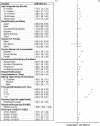Contact tracing: Characteristics of COVID-19 cases that provided contacts
- PMID: 37917769
- PMCID: PMC10621982
- DOI: 10.1371/journal.pone.0293208
Contact tracing: Characteristics of COVID-19 cases that provided contacts
Abstract
This cross-sectional study evaluated COVID-19 contact tracing efforts to identify variations in contact tracing outcomes in different population subgroups. Contact tracing was a critical tool to slow the COVID-19 epidemic. A literature gap evaluating contact tracing elicitation exits, particularly on prioritized groups. We analyzed data from COVID-19 cases linking statewide case management, immunization, laboratory testing, and hospitalization databases in New York State (NYS) outside of New York City from February 1 to November 30, 2021. Focus was cases in home-based residential settings (excluding congregate care) and prioritized groups (educational institutions, large households, close quarters, higher-risk persons, hospitalized). The primary outcome was completed interviews that provided a contact. Of the 550,850 cases interviewed during the study period, 316,645 (57.5%) provided at least one contact. Adults aged 18 to 49 years were most likely to provide contacts than those aged 65 years and older (adjusted odds ratio [aOR], 1.42; 95% confidence interval [CI], 1.39-1.45). Compared to unvaccinated cases, boosted individuals (aOR, 1.61; 95% CI, 1.50-1.73) were most likely to provide contacts, followed by persons with only a primary vaccine series (aOR, 1.3; 95%CI, 1.28-1.33) and partially vaccinated (aOR, 1.21; 95%CI, 1.18-1.24). Repeat cases (aOR, 1.07; 95%CI, 1.01-1.14), pregnant persons (aOR, 1.26; 95% CI, 1,19-1.34), those with underlying conditions (aOR 1.22; 95%CI, 1.20-1.23), and those in K-12 settings (aOR 1.55; 95%CI, 1.50-1.61) were more likely to provide contacts. There was no clear association between hospitalized, while zip code level income may (aOR, 1.006; 95%CI, 1.003, 1.009). Persons from larger households were more likely to provide contacts: aOR for two or more persons vs. one person households ranged from 2.49 to 4.7 (95%CI, 2.20-4.78). Our findings indicate success in eliciting contacts from prioritized groups and identify variable contact elicitation outcomes from different population groups. These results may serve as a tool for future contact tracing efforts.
Copyright: © 2023 Dorabawila et al. This is an open access article distributed under the terms of the Creative Commons Attribution License, which permits unrestricted use, distribution, and reproduction in any medium, provided the original author and source are credited.
Conflict of interest statement
NO authors have competing interests.
Figures


References
-
- New York State Department of Health. Reinfections and First Infections Over Time, By Region. Available from: https://coronavirus.health.ny.gov/covid-19-reinfection-data
-
- World Health Organization. Coronavirus disease (COVID-19): Contact tracing. Available from https://www.who.int/news-room/questions-and-answers/item/coronavirus-dis...
Publication types
MeSH terms
LinkOut - more resources
Full Text Sources
Medical
Miscellaneous

